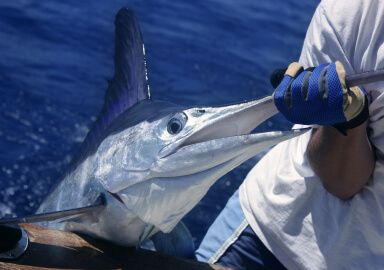Longbill Spearfish
A solitary predator, the longbill spearfish often makes an unexpected catch for anglers trolling in the offshore subtropical areas of the Atlantic Ocean.
View 2 listings
2
listings
–
price starting from
2
countries
–
to the nearest trip
Where and When?
Longbill spearfish are a fish of the warmer areas of both sides of the Atlantic Ocean. In the west, they can be found from offshore of New Jersey, through the Caribbean Sea and Gulf of Mexico and as far south as Venezuela. In the eastern Atlantic Ocean, the longbill spearfish can be caught from Spanish waters southwards to South Africa.
The longbill spearfish are usually found offshore in the upper levels of the water column, but they are not attracted by structure or floating debris. They are not a shoaling species, but live a solitary life without any known large-scale migrations. Within their range they are present throughout the year and may be caught at any time, particularly in the more equatorial areas. They feed mostly in the daylight.
About Longbill Spearfish
The longbill spearfish, Tetrapturus pfluegeri, belongs to the Xiphidae family, which also contains the marlins and sailfish. It can be distinguished from the shortbill spearfish, Tetrapturus angustirostris, by its bill being almost twice the length of the lower jaw. The basic body shape is similar to marlins, but more elongated, and the front of the dorsal fin is higher than all the family except the sailfish. The body is dark blue on the upper side, white with sometimes some brown on the flanks and silvery white on the belly.
The longbill spearfish can attain 254 cm. (100 in.) with a reported maximum mass of 58 kg. (128 lbs.). They have no teeth, but the mouths are armed with sharp, bony jaws that gulp in or bite off bits of fish. They feed mostly on pelagic shoaling fish, such as tunas and flying fish, but will also take squid. The longbill spearfish are nowhere abundant and only occasionally caught by anglers
How to Catch?
Although it can be a moderate size and give an excellent fight, few people specifically target the longbill spearfish, unless they are ticking off their “bucket list". The main reason is not related to any poor fighting ability, or even bad taste, but simply as they are few and far between, and aren’t as predictable as, for instance, mahi-mahi, which can be counted to hang around any fish aggregating devices. Most longbill spearfish are usually caught by sport fishers trolling offshore targeting the larger and more popular marlins.
trolling is the best method for catching this species as the lures or baits are kept close to the surface, where the longbill spearfish hunts, and much distance can be covered giving a better chance of finding a spearfish. The best baits are similar to those for marlin, but smaller, and although not common, spearfish may still be more abundant than marlin. On light tackle, longbill spearfish can provide a temporary diversion and sometimes exciting alternative to trolling endlessly for marlin.






